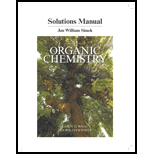
Concept explainers
(a)
To determine: The structure for the given compound.
Interpretation: The structure for the given compound is to be drawn.
Concept introduction:
(a)
Answer to Problem 7.40SP
The structure of
Explanation of Solution
The given compound is
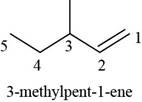
Figure 1
(b)
To determine: The structure for the given compound.
Interpretation: The structure for the given compound is to be drawn.
Concept introduction: Alkenes and alkynes are unsaturated hydrocarbons and are named by identifying the longest chain of carbon atoms that contain double or triple bond, their names end by adding suffix –ene and –yne to the parent hydrocarbon.
(b)
Answer to Problem 7.40SP
The structure of
Explanation of Solution
The given compound is
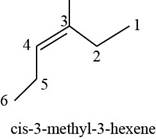
Figure 2
(c)
To determine: The structure for the given compound.
Interpretation: The structure for the given compound is to be drawn.
Concept introduction: Alkenes and alkynes are unsaturated hydrocarbons and are named by identifying the longest chain of carbon atoms that contain double or triple bond, their names end by adding suffix –ene and –yne to the parent hydrocarbon.
(c)
Answer to Problem 7.40SP
The structure of
Explanation of Solution
The given compound is
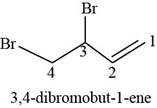
Figure 3
(d)
To determine: The structure for the given compound.
Interpretation: The structure for the given compound is to be drawn.
Concept introduction: Alkenes and alkynes are unsaturated hydrocarbons and are named by identifying the longest chain of carbon atoms that contain double or triple bond, their names end by adding suffix –ene and –yne to the parent hydrocarbon.
(d)
Answer to Problem 7.40SP
The structure of
Explanation of Solution
The given compound is
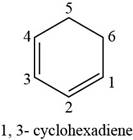
Figure 4
(e)
To determine: The structure for the given compound.
Interpretation: The structure for the given compound is to be drawn.
Concept introduction: Alkenes and alkynes are unsaturated hydrocarbons and are named by identifying the longest chain of carbon atoms that contain double or triple bond, their names end by adding suffix –ene and –yne to the parent hydrocarbon.
(e)
Answer to Problem 7.40SP
The structure of
Explanation of Solution
The given compound is
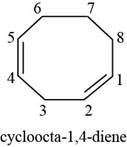
Figure 5
(f)
To determine: The structure for the given compound.
Interpretation: The structure for the given compound is to be drawn.
Concept introduction: Alkenes and alkynes are unsaturated hydrocarbons and are named by identifying the longest chain of carbon atoms that contain double or triple bond, their names end by adding suffix –ene and –yne to the parent hydrocarbon.
(f)
Answer to Problem 7.40SP
The structure of
Explanation of Solution
The given compound is
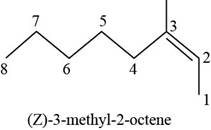
Figure 6
(g)
To determine: The structure for the given compound.
Interpretation: The structure for the given compound is to be drawn.
Concept introduction:
(g)
Answer to Problem 7.40SP
The structure of vinylcyclopropane is shown in Figure 7.
Explanation of Solution
The given compound is vinylcyclopropane. The root name cyclopropane signifies three carbon atoms in a ring. Vinyl group is the

Figure 7
(h)
To determine: The structure for the given compound.
Interpretation: The structure for the given compound is to be drawn.
Concept introduction: Alkenes and alkynes are unsaturated hydrocarbons and are named by identifying the longest chain of carbon atoms that contain double or triple bond, their names end by adding suffix –ene and –yne to the parent hydrocarbon.
(h)
Answer to Problem 7.40SP
The structure of
Explanation of Solution
The given compound is
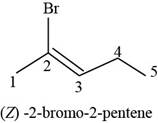
Figure 8
(i)
To determine: The structure for the given compound.
Interpretation: The structure for the given compound is to be drawn.
Concept introduction: Alkenes and alkynes are unsaturated hydrocarbons and are named by identifying the longest chain of carbon atoms that contain double or triple bond, their names end by adding suffix –ene and –yne to the parent hydrocarbon.
(i)
Answer to Problem 7.40SP
The structure of
Explanation of Solution
The given compound is
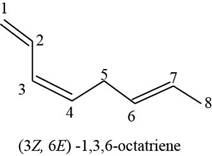
Figure 9
Want to see more full solutions like this?
Chapter 7 Solutions
Student's Solutions Manual for Organic Chemistry
- 1. Arrange the following in order of increasing bond energy (lowest bond energy first, highest bond energy last). Provide your rationale. C=C, C-F, C=C, C-N, C-C List the bond order for each example.arrow_forwardWhat is the major enolate formed when treated with LDA? And why that one?arrow_forward4. Calculate the total number of sigma bonds and total number of pi bonds in each of the following compounds. a. HH :D: +1 I H-N-C-C-O-H I H b. HH H Н :N=C-C-C=C-CEC-H :0: total o H-C-H H-C = `C-H I H. 11 H-C = C= CH H total o total π total π 1 Harrow_forward
- In the following reaction, what quantity in moles of CH₃OH are required to give off 4111 kJ of heat? 2 CH₃OH (l) + 3 O₂ (g) → 2 CO₂ (g) + 4 H₂O(g) ∆H° = -1280. kJarrow_forwardIndicate the processes in the dismutation of Cu2O.arrow_forward1. Consider these three reactions as the elementary steps in the mechanism for a chemical reaction. 2600 2400 2200 2000 1800 1600 1400 1200 1000 800 Potential Energy (kJ) 600 400 200 0 -200- -400 -600- -800 (i) Cl₂ (g) + Pt(s) → 2Cl (g) + Pt(s) (ii) Cl (g)+ CO (g) + Pt (s) → CICO (g) + Pt (s) Ea = 1550 kJ Ea = 2240 kJ (iii) Cl (g) + CICO (g) → Cl₂CO (g) Ea = 2350 kJ AH=-950 kJ ΔΗ = 575 ΚΙ AH=-825 kJ a. Draw the potential energy diagram for the reaction. Label the data points for clarity. The potential energy of the reactants is 600 kJ Reaction Progress b. What is the overall chemical equation? c. What is the overall change in enthalpy for the above chemical reaction? d. What is the overall amount of activation energy for the above chemical reaction? e. Which reaction intermediate would be considered a catalyst (if any) and why? f. If you were to add 2700kJ of energy to the reaction (e.g. 2700 kl of heat or electricity), would you be able to make the reaction reverse itself (i.e. have…arrow_forward
- draw the enolate anion and the carbonyl that would be needed to make this product through an aldol addition reaction.arrow_forwardDraw the Michael Adduct and the final product of the Robinson annulation reaction. Ignore inorganic byproducts.arrow_forwardDraw the Michael adduct and final product of the Robinson annulation reaction. Ignore inorganic byproductsarrow_forward
- Post Lab Questions. 1) Draw the mechanism of your Diels-Alder cycloaddition. 2) Only one isomer of product is formed in the Diels-Alder cycloaddition. Why? 3) Imagine that you used isoprene as diene - in that case you don't have to worry about assigning endo vs exo. Draw the "endo" and "exo" products of the Diels-Alder reaction between isoprene and maleic anhydride, and explain why the distinction is irrelevant here. 4) This does not hold for other dienes. Draw the exo and endo products of the reaction of cyclohexadiene with maleic anhydride. Make sure you label your answers properly as endo or exo. 100 °C Xylenes ??? 5) Calculate the process mass intensity for your specific reaction (make sure to use your actual amounts of reagent).arrow_forwardIndicate the product(s) A, B C and D that are formed in the reaction: H + NH-NH-CH [A+B] [C+D] hydrazonesarrow_forwardHow can you prepare a 6 mL solution of 6% H2O2, if we have a bottle of 30% H2O2?arrow_forward
 ChemistryChemistryISBN:9781305957404Author:Steven S. Zumdahl, Susan A. Zumdahl, Donald J. DeCostePublisher:Cengage Learning
ChemistryChemistryISBN:9781305957404Author:Steven S. Zumdahl, Susan A. Zumdahl, Donald J. DeCostePublisher:Cengage Learning ChemistryChemistryISBN:9781259911156Author:Raymond Chang Dr., Jason Overby ProfessorPublisher:McGraw-Hill Education
ChemistryChemistryISBN:9781259911156Author:Raymond Chang Dr., Jason Overby ProfessorPublisher:McGraw-Hill Education Principles of Instrumental AnalysisChemistryISBN:9781305577213Author:Douglas A. Skoog, F. James Holler, Stanley R. CrouchPublisher:Cengage Learning
Principles of Instrumental AnalysisChemistryISBN:9781305577213Author:Douglas A. Skoog, F. James Holler, Stanley R. CrouchPublisher:Cengage Learning Organic ChemistryChemistryISBN:9780078021558Author:Janice Gorzynski Smith Dr.Publisher:McGraw-Hill Education
Organic ChemistryChemistryISBN:9780078021558Author:Janice Gorzynski Smith Dr.Publisher:McGraw-Hill Education Chemistry: Principles and ReactionsChemistryISBN:9781305079373Author:William L. Masterton, Cecile N. HurleyPublisher:Cengage Learning
Chemistry: Principles and ReactionsChemistryISBN:9781305079373Author:William L. Masterton, Cecile N. HurleyPublisher:Cengage Learning Elementary Principles of Chemical Processes, Bind...ChemistryISBN:9781118431221Author:Richard M. Felder, Ronald W. Rousseau, Lisa G. BullardPublisher:WILEY
Elementary Principles of Chemical Processes, Bind...ChemistryISBN:9781118431221Author:Richard M. Felder, Ronald W. Rousseau, Lisa G. BullardPublisher:WILEY





